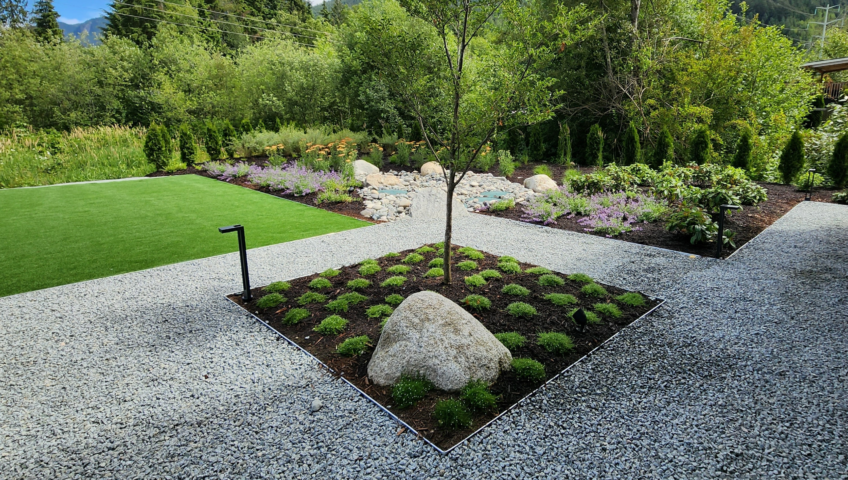Imagine stepping into your backyard: a verdant oasis that not only mesmerizes the senses but also thrives with minimal maintenance. This dream can be a reality, thanks to the revolution in sustainable landscaping! Today, we’ll dive into an exciting exploration of innovative materials and trends in landscaping that craft beautiful, eco-conscious outdoor spaces. From rain gardens to porous pavers, the future of landscaping is sustainable, breathtaking, and right at your fingertips.
No Limit Landscaping highlights several innovative materials that are making an impact in the industry. These include sustainable options like recycled and reclaimed materials, as well as incorporating metals for shade structures, artistic panels, water features, and planter boxes. Additionally, low-carbon landscaping emphasizes the use of local plants, herbs, veggies, and fruit to reduce the carbon footprint.
Innovative Materials in Landscaping
Designing a sustainable outdoor living space extends beyond traditional plant selections and garden accessories. It also includes the materials used to create the space, from hardscaping to paving systems. Landscapers have increasingly turned to innovative materials that can offset some of the negative environmental impacts of traditional materials while still providing an aesthetically pleasing result.
Composite and Recycled Materials
These materials offer a great alternative to concrete or wood, as they are known for their durability and resilience. Composite decking, which mimics the look of traditional wooden boards, is made from recycled plastic and wood fiber. This makes it ideal for outdoor spaces, as it’s resistant to moisture, fading and scratches. Composite materials can also be used in landscape designs through edging products like landscape timber, which is made out of recycled plastic. They make excellent alternatives to chemically treated lumber that can adversely affect soil quality over time.
Recycled materials such as crushed concrete and glass are also being used creatively within sustainable gardens, with striking effects when combined with natural elements. These recycled materials provide unique texture, color, and interest to any garden project while reducing landfill waste. For instance, old wine bottles and beer cans are being converted into mesmerizing landscape pieces that are both beautiful and environmentally friendly at the same time.
Ultimately, opt for contractors who embrace these eco-friendly principles in their techniques. Integrating these recycling options will undoubtedly provide aesthetic benefits but also help address societal concerns around sustainability in a growing global environment that demands ethical landscaping practices that do not harm our planet.
Advanced Soil and Paving Systems
One of the biggest factors in sustainable landscaping is soil health. Healthy soil not only supports plant growth but also regulates water supply, mitigates stormwater runoff, and sequesters carbon. Utilizing innovative, advanced soil systems can be an excellent first step towards building a sustainable landscape.
Advanced soil systems include mixes that contain organic matter and beneficial microbes that help plants grow while utilizing water efficiently. These materials also break down over time, adding vital nutrients to the soil as they decompose. On the other hand, traditional paving materials like asphalt and concrete can have a negative impact on the environment. Porous paving options like permeable concrete grids and open-cell pavers allow rainwater infiltration directly into the ground rather than causing flooding or erosion.
| Advanced Soil Systems | Paving/Hardscape Systems |
| Organic matter mixtures | Permeable concrete grids |
| Beneficial microbes | Open-cell pavers |
| Water efficiency usage |
Stone, Rocks, and Other Natural Materials
Landscaping with natural stones and rocks has been long-standing for a reason: they are eco-friendly, low-maintenance, and sustainable. Using large stones or boulders to build retaining walls or natural borders creates a unique focal point while minimizing water usage. Adding pebble finishes or crushed stone near walkways blends naturally into the surrounding landscape while controlling dust, mud accumulation, and erosion around planting beds.
Besides being sustainable, using local stones or rocks sourced close to your project site supports small businesses in your community. Incorporating reclaimed materials like salvaged brick walls or rusted metal edging can add charm while reducing waste generation. When sustainable landscaping is put into practice using natural materials like stones and rocks, the results can be stunning. With sustainability at the forefront of the design process, spaces become more than functional; they become living works of art that provide beauty and ecological benefits to our environment.
Sustainability in Landscaping: Drought-Resistant and Eco-Friendly Options
As eco-friendliness continues to shape the landscaping industry, homeowners are looking for ways to create their dream outdoor spaces without compromising on sustainability. One way to achieve this balance is by choosing drought-resistant plants that can survive with minimal water requirements. Such plants include succulents, cacti, and other native plant species that thrive in a particular region’s climate.
Eco-friendly hardscaping materials like permeable pavement, gravel and porous pavers are excellent solutions for reducing stormwater runoff, thus preventing erosion and flooding while recharging groundwater sources. Garden structures made from natural or recycled materials like wooden trellises, reclaimed metal, or bamboo add character and can be used to support climbing plants or provide seating areas.
Trends in Landscaping 2024
Trends in landscaping for 2024 focus on functional outdoor living spaces that embrace the environment, as seen through the increase of sustainable features such as rain gardens and bioswales, among others. The popularity of outdoor kitchens and dining areas continues to rise, allowing homeowners to entertain guests while taking advantage of their landscape’s existing layout. Fire pits, both big and small, add warmth and visual interest. Edimentals, such as the Chilean guava, once solely grown by garden enthusiasts, are going mainstream as people seek new ways to use their yards. Native plants like flowering heaths will also prominently feature in 2024 home landscapes.
Creating natural habitats for wildlife is another big trend in 2024 as people become more aware of the need to live harmoniously with nature. Providing comfortable living spaces for butterflies, bees, and hummingbirds, along with bird feeders, adds color and life to the rural setting. It’s much like welcoming visitors into your home. You would want them to feel comfortable and at ease when they visit. Creating a comfortable living environment for wildlife guests ensures that they are welcome and assists in preserving the ecosystem. Smart technology like wifi-enabled lights and irrigation systems controlled by apps will also continue to gain traction in 2024, allowing property owners to control landscape features remotely.
Enhancing Wildlife Habitats
In this era of environmental consciousness, sustainable landscaping expands to encompass the inclusion of diverse wildlife species. The practice involves an examination of ecosystems within outdoor spaces, with a focus on creating environments appropriate for various fauna. Homeowners are looking for ways to create gardens that welcome native creatures and promote biodiversity. Incorporating diverse elements into landscape design can help attract species such as bees, birds, dragonflies, butterflies, and small mammals.
Sheltered spaces such as nesting boxes or birdhouses can provide a roosting location for feathered friends like swallows and bluebirds. Pollinator gardens give butterflies nourishment while adding visual splendor to gardens with vibrant colors and nectar sources. Similarly, incorporating water features such as birdbaths or small ponds can act as a valuable source of water for animals during the dry summer months. Diversity is key to enhancing habitat suitability; planting trees and shrubs native to your region makes it much easier for animals to thrive. Providing food sources such as fruiting trees and seeds from wildflowers also assists in encouraging local fauna species to inhabit outdoor spaces.
Defined Outdoor Spaces
Homeowners continue to redefine their interpretation of outdoor spaces, no longer seeing them solely as areas meant for gardening but instead as multi-functional living rooms capable of meeting practical daily needs. With an increasing demand for private nooks tailored for relaxation and entertainment purposes alike comes the need to personalize outdoor spaces that reflect individual style and preferences. As homeowners seek a more defined identity for outdoor spaces, garden designers are paying attention to this trend by creating high-yielding functional areas such as outdoor kitchens, dining areas, home offices and fire pits, among others. These additions extend indoor living spaces beyond walls, providing opportunities to experience nature without leaving home.
In recent years, this trend has gathered momentum with the addition of a diverse range of outdoor living features such as yoga decks, hammocks and porches that provide serene locations suitable for relaxation. These purpose-specific areas make it easier to enjoy life outside and provide intimate gathering places for socializing among family and friends. Understanding how sustainable landscaping affects outdoor spaces by creating multi-functional living spaces and wildlife habitats creates distinctive outdoor experiences. Finally, let’s examine how we can incorporate environmental impact into our endeavors.
Considering Environmental Impact in Landscaping Endeavors
Sustainable landscaping involves considering the environmental impact of materials and techniques used in creating outdoor spaces. Not all landscaping products are created equal, and it’s crucial to choose eco-friendly options to minimize carbon footprints and safeguard the environment. This means considering factors such as water conservation, plant biodiversity, energy usage, and maintenance practices.
It’s essential to choose environmentally approved materials when building hardscapes such as patios or retaining walls. Recycled plastic lumber is an excellent example of a sustainable material that’s obtained from discarded plastic waste. Additionally, it requires low maintenance and doesn’t rot or splinter like traditional wood would, making it an ideal option for outdoor use.
As a homeowner looking towards building a sustainable landscape design, understanding what materials have a minimal environmental impact compared to less favorable options is essential. Consult with experts at No Limit Landscaping on suitable designs and material selection when executing your landscaping project. Feel free to ask any landscape design or construction questions over the phone at 604-559-9882. No Limit Landscaping is the Lower Mainland’s #1 landscape construction and design company. Let’s create your dream landscape together! Call now!


